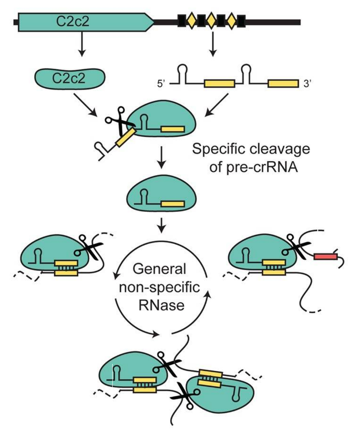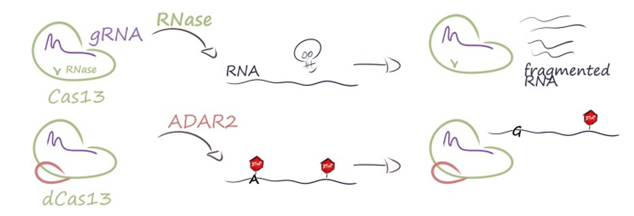
Our promise to you:
Guaranteed product quality, expert customer support.
 24x7 CUSTOMER SERVICE
24x7 CUSTOMER SERVICE
 CONTACT US TO ORDER
CONTACT US TO ORDER
Therapeutic Applications of CRISPR/Cas13 
Recently, Cas13 has been shown to be able to target RNA instead of DNA for editing. Established members of the Cas13 protein family include Cas13a (formerly known as C2c2), Cas13b, and Cas13c. In 2017, Abudayyeh and colleagues demonstrated that CRISPR/Cas13 could be a flexible platform for studying RNA in mammalian cells. This represents that Cas13 is a potentially safe alternative to Cas9 because it induces a loss of functioning phenotype without causing loss of the target gene sequence.
Two distinct RNase activities of CRISPR/Cas13
Unlike most dsDNA-targeted CRISPR systems, Cas13 has two advanced eukaryotic and prokaryotic nucleotide-binding (HEPN) domains that target single-stranded RNA (ssRNA). Together they form a ribonuclease active site, enabling it to act as an RNA-guided RRNA endonuclease (as a single-stranded RNA (ssRNA) substrate). In addition, studies show that Cas13 has a unique ribonuclease activity responsible for CRISPR RNA maturation, which is different from its RNA-activated ssRNA degradation activity. The functions of these double ribonucleases differ chemically and mechanically from each other. The two ribonuclease activities of Cas13 enable multiplex processing and direct RNA loading, allowing sensitive cell transcript detection.
 Figure 1: Model of the Type VI CRISPR pathway highlighting both of C2c2’s ribonuclease activities. (Alexandra East-Seletsky. 2016)
Figure 1: Model of the Type VI CRISPR pathway highlighting both of C2c2’s ribonuclease activities. (Alexandra East-Seletsky. 2016)
Application of Cas13 for Nucleic Acid Detection and Targeting
Gootenberg, etc. used Cas13a, a CRISPR effector that targets RNA, to develop a Cas13a-based molecular detection platform called SHERLOCK (specific high-sensitivity enzyme reporter gene unlock) for in vitro detection of DNA and RNA with a single-base mismatch specificity and attomolar sensitivity.
- SHERLOCK and virus diagnosis
Cameron Myhrvold's research shows that Cas13a-based SHERLOCK can detect any virus, virus resistance mutations, and clinically relevant virus single nucleotide polymorphisms in body fluids.
- Detection of low-frequency cancer somatic mutations in cfDNA fragments
SHERLOCK can detect nucleic acids in patients with serum or urine at low to low Armole concentrations, which can detect tumor mutations in cell-free DNA (cfDNA).
In addition, nuclease-inactivated dCas13, which appears as an RNA-directed RNA-binding protein without endonuclease activity, can be fused with spectrally separated fluorescent proteins to enable visualization of endogenous RNA and its transport in living cells. This method is undoubtedly a cutting-edge tool suitable for monitoring the characteristics of transcript localization and related regulatory pathways in real-time, as well as specific molecular mechanisms associated with well-characterized mRNAs.
CRISPR/Cas13 and gene therapy
- Cas13-like RNA-directed RNA nucleases—For example, mRNA for dynamic knockout of disease-causing genes
- The fusion of the non-catalytically active PspCas13b to the ADAR2 deaminase domain (ADAR2 DD) for the reporter gene's A to I (G) replacement (REPAIR) and endogenous transcripts and disease-related mutations.
 Figure 2: Therapeutic strategies based on CRISPR/Cas13-based tools. (Panayiota Papasavva. 2019)
Figure 2: Therapeutic strategies based on CRISPR/Cas13-based tools. (Panayiota Papasavva. 2019)
To date, most research has focused on type II Cas9 proteins. However, much remains to be discovered about the role of Cas13 in biomedical and disease treatment.
CRISPR/Cas9 PlatformCB is one of the leading biotechnology companies dedicated to providing customers with CRISPR system solutions to promote scientific research, drug development, disease treatment research, and more. Our scientists have deep pharmacological knowledge and rich experience in experimental operation and data processing. Whether you need sgRNA design and synthesis or Cas13 vector construction, our trained experts will support you with their strong problem-solving capabilities and expertise. Contact us to learn more about our services. Looking forward to working with you in the future.
References
- Alexandra East-Seletsky. et al. Two Distinct RNase Activities of CRISPR-C2c2 Enable Guide RNA Processing and RNA Detection. Nature. 2016; 538(7624):270–273.
- Authors and affiliations. et al. CRISPR-Cas12 and Cas13: the lesser known siblings of CRISPR-Cas9. Cell Biology and Toxicology. 2019; 35(6):489–492.
- Cameron Myhrvold. et al. Field-deployable viral diagnostics using CRISPR-Cas13. Science. 2018; 360(6387):444–448.
- Chun-Hao Huang. et al. Applications of CRISPR-Cas Enzymes in Cancer Therapeutics and Detection. Trends Cancer. 2018; 4(7):499–512.
- David B.T. Cox. et al. RNA Editing with CRISPR-Cas13. Science. 2017; 358(6366):1019–1027.
- Javier T. Granados-Riveron and Guillermo Aquino-Jarquin. CRISPR–Cas13 Precision Transcriptome Engineering in Cancer. Cancer Research. 2018; 78(15):4107-4113.
- Jonathan S. et al. Gootenberg Multiplexed and portable nucleic acid detection platform with Cas13, Cas12a, and Csm6. Science. 2018; 360(6387):439–444.
- Omar O. et al. Abudayyeh RNA targeting with CRISPR-Cas13a. Nature. 2017; 550(7675):280–284.
- Panayiota Papasavva. et al. Rare Opportunities: CRISPR/Cas-Based Therapy Development for Rare Genetic Diseases. Mol Diagn Ther. 2019; 23(2):201–222.
- Sergey Shmakov. et al. Discovery and functional characterization of diverse Class 2 CRISPR-Cas systems. Mol Cell. 2015; 60(3):385–397.
- Silvana Konermann. et al. Transcriptome engineering with RNA-targeting Type VI-D CRISPR effectors. Cell. 2018; 173(3):665–676.e14.